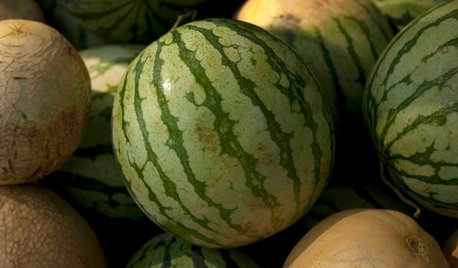Spraying Cucumbers and melons
jimmy56_gw (zone 6 PA)
9 years ago
Related Stories

GARDENING GUIDESSummer Crops: How to Grow Melons
Drink in the refreshing sweetness of melons from your own garden this summer — they can last well into fall too
Full Story
EDIBLE GARDENSGarden BFFs? Why Your Vegetables Are Begging for Companion Plants
Foster friendships among plants for protection from pests, pollination support and color camaraderie
Full Story
EDIBLE GARDENSSummer Crops: How to Grow Watermelons
You might not need as much space as you think to get this summer mainstay to spring up in your garden
Full Story
FARM YOUR YARD6 Things to Know Before You Start Growing Your Own Food
It takes time and practice, but growing edibles in the suburbs or city is possible with smart prep and patience
Full Story
GARDENING GUIDESOrganic Matters: Thwart Insect Pests With Trap Crops
Add a few sacrificial plants to your garden to lure insects away from the harvest
Full Story
EDIBLE GARDENSHow to Grow Your Own Sweet Summer Crops
This guide will help any gardener get started on growing the freshest warm-season veggies and berries for summer
Full Story
FARM YOUR YARDHow to Grow Vegetables in Containers
Get glorious vegetables and fruits on your patio with a pro’s guidance — including his personal recipe for potting mix
Full Story
EDIBLE GARDENSSummer Crops: How to Grow Squash
Almost foolproof and with cheerful flowers, squash comes in a wide range of varieties to plant in spring
Full Story
FARM YOUR YARDIf You Have Room for Only One Summer Crop ...
Get an edible that’s long on flavor even if you’re short on space, with a long-time gardener’s favorite picks
Full Story
GARDENING GUIDES10 Easy Edibles for First-Time Gardeners
Focus on these beginner-friendly vegetables, herbs, beans and salad greens to start a home farm with little fuss
Full StorySponsored
Custom Craftsmanship & Construction Solutions in Franklin County
More Discussions






FrancoiseFromAix
jimmy56_gw (zone 6 PA)Original Author
Related Professionals
Wake Forest Landscape Contractors · Bell Gardens Landscape Contractors · Bloomington Landscape Contractors · Chattanooga Landscape Contractors · Eureka Landscape Contractors · Flagstaff Landscape Contractors · Fort Atkinson Landscape Contractors · Merced Landscape Contractors · Middletown Landscape Contractors · Painesville Landscape Contractors · Plymouth Landscape Contractors · Weymouth Landscape Contractors · Ashburn Driveway Installation & Maintenance · Hockessin Driveway Installation & Maintenance · Roy Driveway Installation & Maintenanceltilton
jimmy56_gw (zone 6 PA)Original Author
FrancoiseFromAix
FrancoiseFromAix
ltilton
FrancoiseFromAix